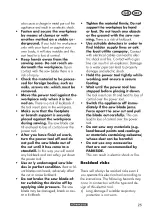
23
MT
GB
3) PERSOnAL SAFETy
a)
Stay alert, watch what you are
doing and use common sense
when operating a power tool.
Do not use a power tool while
you are tired or under the influ
-
ence of drugs, alcohol or medi-
cation.
A moment of inattention white
operating power tools may result in
serious personal injury.
b)
Use personal protective equip-
ment. Always wear eye protec-
tion.
Protective equipment such as dust
mask, non-skid safety shoes, hard hat,
or hearing protection used for appro
-
priate conditions will reduce personal
injuries.
c)
Prevent unintentional star-
ting. Ensure the switch is in the
off-position before connecting
to power source and/or battery
pack, picking up or carrying
the tool.
Carrying power tools with
your finger on the switch or energising
power tools that have the switch on
invites accidents.
d)
Remove any adjusting key or
wrench before turning the po-
wer tool on.
A wrench or a key left
attached to a rotating part of the po
-
wer tool may result in personal injury.
e)
Do not overreach. Keep proper
footing and balance at all times.
This enables better control of the po
-
wer tool in unexpected situations.
f)
Dress properly. Do not wear
loose clothing or jewellery.
Keep your hair, clothing and
gloves away from moving
parts.
Loose clothes, jewellery or long
hair can be caught in moving parts.
g)
If dust extraction and collection
devices can be installed, make
sure that these are connected
and used correctly.
Use of dust col
-
lection can reduce dust-related hazards.
h) Do not allow yourself to be lul-
led into a false sense of security
and do not disregard the safety
rules for power tools, even if
you are familiar with the power
tool after using it many times.
Careless action can lead to serious
injuries within a fraction of a second.
4) POWER TOOL USE AnD CARE
a)
Do not force the power tool. Use
the correct power tool for your
application.
The correct power tool
will do the job better and safer at the
rate for which it was designed.
b)
Do not use the power tool if the
switch does not turn it on and
off.
Any power tool that cannot be
controlled with the switch is dangerous
and must be repaired.
c)
Remove the plug from the wall
socket and/or remove the re-
chargeable battery before you
change the device’s settings,
change accessory parts or put
away the power tool.
Such preven
-
tive safety measures reduce the risk of
starting the power tool accidentaIly.
d)
Store idle power tools out of the
reach of children and do not al-
low persons unfamiliar with the
power tool or these instructions
to operate the power tool.
Power
tools are dangerous in the hands of
untrained users.
e)
Look after the power tool and
application tool carefully. Check
for misalignment or binding
of moving parts, breakage of
parts and any other condition
Summary of Contents for PASA 20-Li A1
Page 182: ...182 SI...
Page 196: ...196...
















































